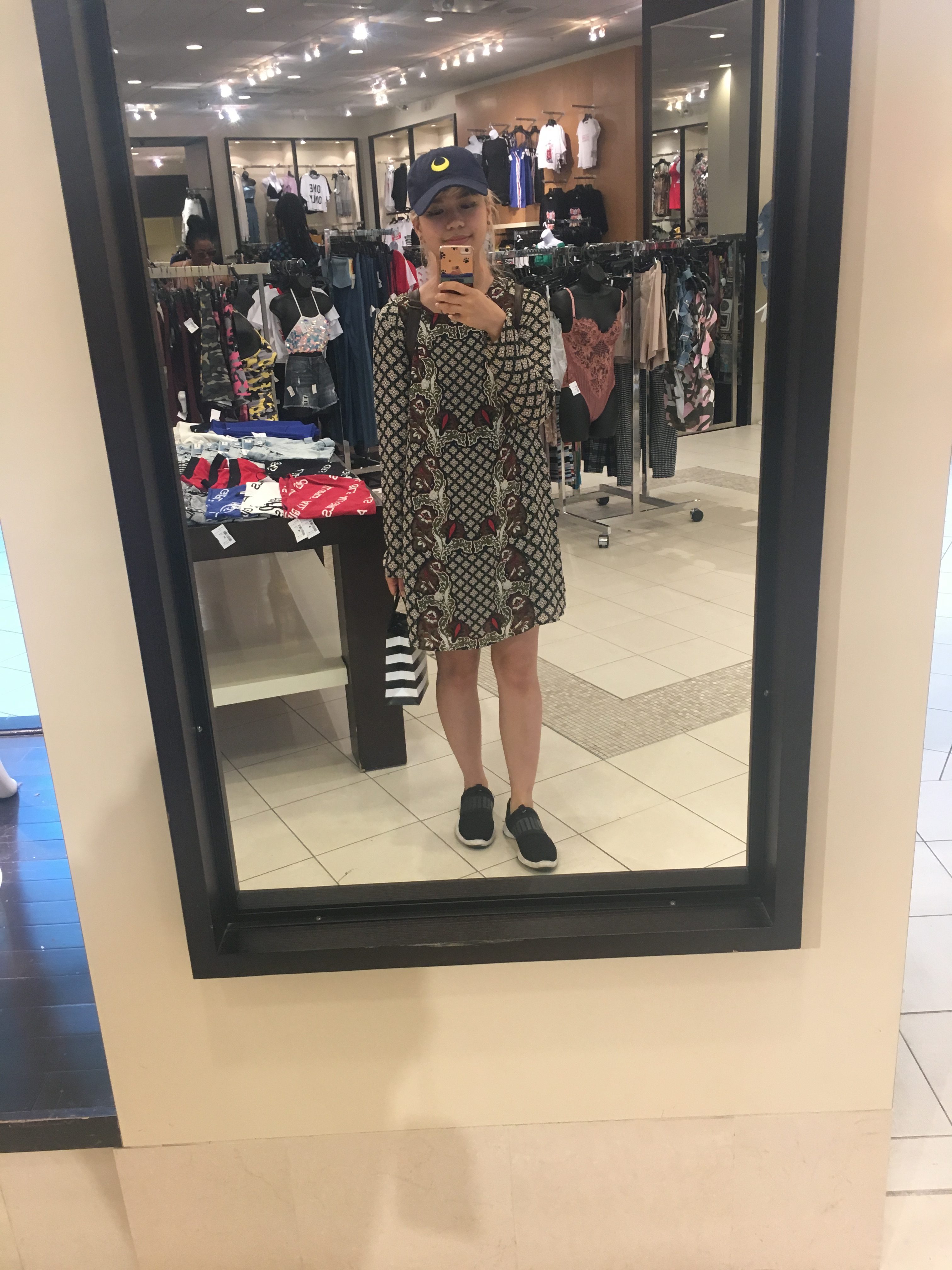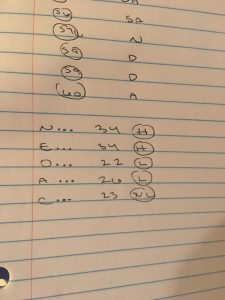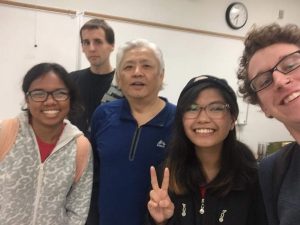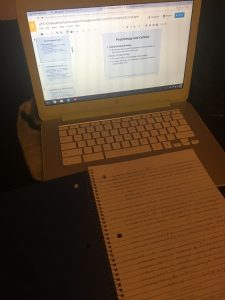Blog 10: Reflection

The image above is a picture of me eating a spicy chicken that I thought
I could handle, but it was more spicy than I thought it would be. It is
synonymous to how I felt about this class. I knew that taking an online
course would be a challenge, but I had no idea it would really test my time
management skills. I took the class thinking that my time management
skills were above excellent. I remembered doing a full time job and
having full time school in TCC and being able to ace all my classes,
including an online class. I was able to remember that I had an online
class.
However, what surprises me is that much of my challenge with this class
had to do with remembering that I was taking it. What I realized is that the
university experience is much more rigorous than community college… More
classes than before required more essays and other writing assignments…
I loved reading the chapters when I remembered to complete my assignments.
The topics were always interesting and they challenged me to open my mind
to the ways other cultures think. I believe my cultural lenses have expanded
and are able to observe more than they were able to before. If my grade
in this class is not as good as I wanted, I will be okay. What I find most
important is what I was able to learn about the world and myself. If I were to
take the class again, I would save all the due dates on my phone to help me
remember them. I would also try to see my professor more often to help
explain some ideas I did not understand.
What I will take most from this class is the blogs. They have been an
excellent and fun way for me to reflect on my learning! I appreciate this
new way of learning! It has inspired me to keep a journal to reflect on
my improvements, failures and neutral experiences!
Blog 8: Emotional Perception


The two images above are comparisons of an American cartoon
(Adventure Time) and a Japanese cartoon (Clannad), known as anime.
“Emotion Perception Across Cultures” discusses the importance of
communication through facial expressions and how different cultures
will interpret emotions more clearly through different parts of our face.
For example, a study done in the 1970’s concluded through its research
that “East Asian participants focused on… the eyes and gaze direction,”
while “Western Caucasian participants expected signals of the…
eyebrows and mouth region.” (Psychology Today, 2016)
From my personal experience, I find this research surprising as I think
Americans make more eye contact than Filipinos do. Filipinos also use
their lips to communicate. For example, as a Filipino, I use my lips to
point at objects. Of course, this observation is limited to my own
knowledge of a specific East Asian culture. I am sure it is different with
different East Asian culture!
The pictures above definitely resonate with the above descriptions. The
Japanese characters have bigger, more detailed eyes. The American
characters’ emotions can be read more prominently through their
mouths! The approaches mentioned before can definitely be applied
with these cartoon characters!
The display rules for my culture are similar to what was explained in the
study that involved watching stressful films alone and with a researcher.
The Japanese participants were likely to “conceal negative emotions in
social settings.” It was important for me to stay calm and collected
growing up, neither seeming too happy or sad. If I laughed too much,
my mom told me I would seem too flirtatious. If I was too sad, I would
be too much of a killjoy. I needed to be quiet and pragmatic.
Growing up, I was always jealous of all the American girls who didn’t
need to hide their emotions. Currently, I am quite the bubbly,
emotional mess I am proud to display. I wonder if this makes me
more American.
In any case, this article was a very eye-opening read!
Blog 6: Self-Determination Theory

Self-determination theory is this idea that all cultures require autonomy, competence and relatedness to meet their basic psychological needs. The way in which I meet these needs are quite simple: I express myself through fashion, make-up, and humor. The image above comes from my Instagram, in which I had posted "It was a nice bathroom. Thank you @daveandbusters." I did so to be funny. I also thought my make-up was quite exceptional that day. I look forward to every day that I work and go to school because they are new days to put on make-up, show off my style and make people laugh. These actions help keep me feeling autonomous, or, in other words, "getting that bread." I keep myself feeling competent through my humor. It helps me build relationships and, even if I don't do so well, at least I can make myself smile. My fashion, make-up and humor also help me relate to others. I seldom fail to pass a day without someone asking me about my fashion or makeup choices. I have a strong sense of individuality and thrive in conversation and how it makes me more knowledgeable. It is easy for me to keep myself entertained, and I hope I can also do the same for others, even if it is mostly for me. Wink, wink.
Blog 5: The Independent Me

I asked myself "Who am I?" and came up with the following thoughts: I am Filipino, 21 years old, single and a broke college student. To describe myself in adjectives, I am awkward, funny, hardworking, positive, and mindfully strong. I was asked to analyze whether my responses could be categorized as an independent construal or an interdependent construal, and have concluded that all of them are independent. I describe myself without linking myself to anybody else. In fact, after being asked to categorize these statements, I felt rather guilty for not saying something like I am a daughter or I am friendly and helpful to my peers. With that in mind, I suppose I am more independent than interdependent. A famous quote that first comes to mind that can be used to describe the independent construal of self is "Be you, do you." I grew up having low self esteem and remembered watching these Youtube workout videos by Cassey Ho that supported the idea of self confidence and doing things for oneself. This was one of her quotes that has fixated itself in mind and continues to inspire me today. A lot of my low self esteem came from not feeling like I was a good enough student, daughter, or friend. So, now I try to focus on being good enough for myself before I can even think about being good enough for others. The image above is a picture of me taking a selfie. I like to take pictures of myself for me. I liked my outfit that day and like to save a collection of my own pictures to show how my style has grown. I also went shopping alone that day, treating myself with new makeup. Blog 4: Test 1 Results Review
Tests are intimidating, but a good way to measure how much a student has learned and retained. Firstly, I have noticed that this class does review a lot of the terms and ideas I had learned from my previous sociology, psychology and anthropology classes. If those terms and the ideas had shown up on the test, I could answer them fairly easily. On the other hand, if I had just learned a term or idea, I tended to get those answers wrong. I had not studied for this test as rigorously as I could have. I reviewed all my notes one time right before the test and had not looked at the review once. After reviewing my test results, I realized that I should focus on studying what I had not learned before. I should also look at the test review provided. I chose the image above to visualize how I felt about receiving an 80%. For not studying as well as I should have, I feel as if it is still a good grade. However, I did not do my best. By using the test strategies I had mentioned, I should do better next time.
Blog 3: My NEO test results

“NEO Test Results”
This shows the scores I had added up to after completing my NEO test.
After taking this test, I have gained more insight on the way I approach situations. Here are what my results have concluded: My neuroticism is shown to be high. This means that I react in a way that is emotionally driven. I can see this as true, as it is easy for me to cry. For example, when I get into an argument with a close friend, I initially respond by crying or saying things I do not mean, completely saturated by my feelings in the moment. My extraversion dimension is high and I agree with it. I make time to spend with my friends as much as possible, and am willing to make new friends. My openness dimension is low and this is true to an extent. I am open to new ideas, but am generally stuck in my own ways. For example, I used to always cook my eggs sunny side up. However, my friend had showed me how to cook eggs scrambled, and I was open to learning how to cook my eggs a different way. Now I cook my eggs both ways. My agreeableness dimension score was surprisingly low, as I like to think that I am "compassionate" and "tend to avoid conflict." Although, it is true that I like to get into competition. I believe competition forces an individual to do better and to do so efficiently. However, I only believe in it to an extent. There is a healthy way to approach it, and I believe that working to cooperate is a better value. Lastly, my conscientiousness dimension score was very low. This was not a surprise to me. I like to do things spontaneously, like make boba tea plans last minute. Although, I have found this method very inefficient, especially now that I am back in school and must schedule my time accordingly.
Blog 2: Self-Efficacy… do I have it?

“Chinese Class Flashback”
I chose this image because I remembered taking this class and being very excited to meet this challenge of learning one of the most complex languages. I have taken two semesters of it and thoroughly enjoyed the journey. With my self efficacy, I passed the class with an A and built a good relationship with a professor who has always believed in his students’ ability to learn!
Self-efficacy... Whoa, well, what is that? Well, it refers to the belief that a person can achieve their goals through their own abilities. It's an important trait to have because much of our ability to learn stems from this individual confidence! If you don't believe in you... who will? And, if you were raised that way, not even your parents will always be there to tell you they believe in you. Your relationship with yourself is something you will always have to fall back on. I would like to consider myself a very hard-working student that would do ANYTHING to accomplish something the right way. Even in new jobs, I find myself wanting to be the best worker. I'm very ambitious, but, at the same time, I humble myself to those around me. I realize I am not the best at everything and am willing to learn from those who know better. With these traits in mind, I like to think I have enough confidence in myself as a student. However, one of my biggest challenges is having the confidence to apply this knowledge. This includes speaking in class or discussing with a friend a topic I learned in class with the fear that I am actually getting it all wrong... I could increase my confidence by acknowledging how hard I work. I have worked a full time job and gone to school full time before, still ending the semester with my name on the dean's list. It's time to believe in myself more, and I must learn to apply myself and my learning to the world. After taking the self-efficacy test, I came up with these results: Believe in your ability: 77.5 Ability can grow with effort: 88 Overall: 81.5 These scores surely reflect what I had stated earlier! My belief in my ability is lower than belief that ability can grow with effort. However, these scores are still high enough for me to further believe that I am a great student with great abilities. Again, it is that confidence in myself that I need to work on. After that, I should be set! In conclusion, yes, we all have self-efficacy. How much we have is really what we need to ask ourselves. Thank you for listening to my Ted talk.
Blog 1: Course Objectives and it’s Application

It is the first day of September, and I am ready to start off this month right by attempting to understand how to use WordPress and how to approach my study of cross cultural psychology. After reading the course objectives for this PSYC 420 class, I understand that my approach should be open-minded in order to learn to examine the influence of culture and psychology in the world, understand cultural diversity and its impact on life, interact with people of other cultures and develop skills to apply them to research. With an open mind, one can learn. Culture is one of those subjects in which one must be unprejudiced to a whole way of life and beliefs. I remember in one of my classes, my teacher was playing a song that was sung in a different language about a god. And, unfortunately, I saw one of my classmates chuckle when the English subtitle read that the god had eight eyes and eight legs. To my classmate, it might have been strange to hear about a god with such features. However, to the peoples of that country, the chuckle could have been taken as disrespect. I mention this story, but do recognize that we all have a level of an ethnocentric nature to us. It is inevitable, as we have all been raised to believe and understand things a certain way. I believe understanding the psychology between different cultures will help reduce my bias and levels of ethnocentric thought. As G.I. Joe said, "Knowing is half the battle," and this should be through the application of understanding other cultures. In order to succeed in this course, I understand that I must read the book to learn and participate on WordPress to apply my knowledge. An online class is definitely going to be a challenge, but I believe in my ability to manage my time and focus. Image: I chose this image because I believe that taking good notes is a great way to understand a class that deals with new terminology and complex ideas.The notes that I took in this photo were of Chapter 1 from the book, which I followed with a reading of the module to go with the book notes.
